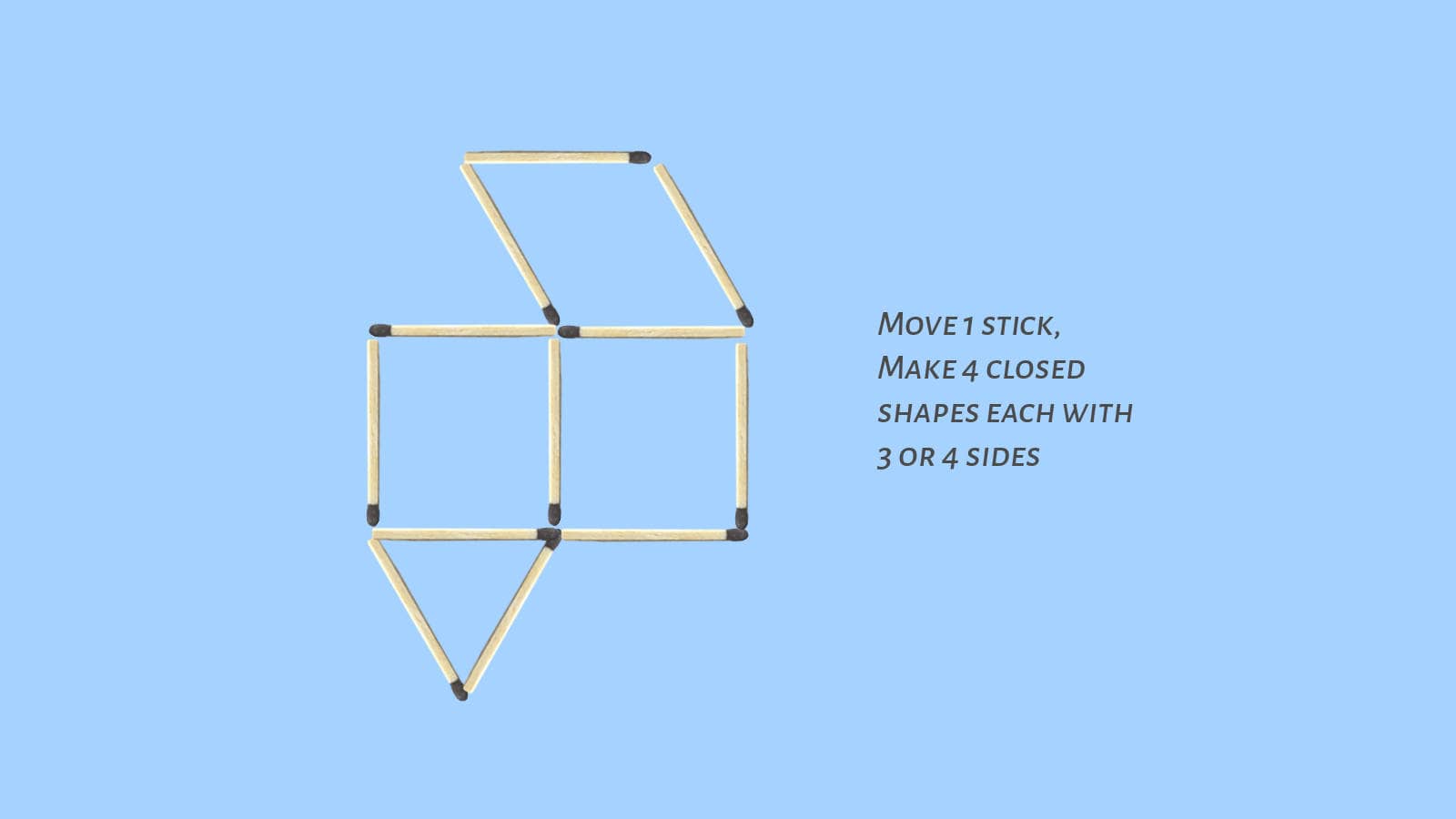
Matchstick puzzle: Move 1 stick to make 4 matchstick shapes
Move 1 stick to make 4 matchstick shapes of triangles, squares or rhombuses. How many such new figures can you make?
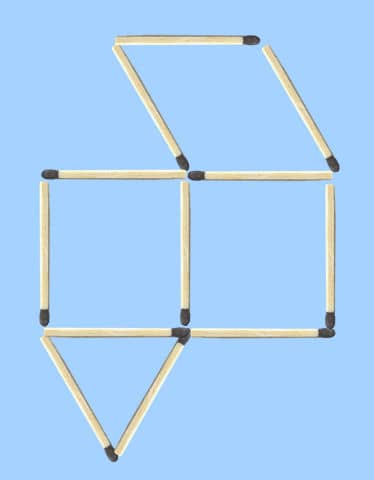
Recommended time: 10 minutes.
Try solving the puzzle. Especially the second part is fun.
A Bonus Puzzle
With the experience of solving the first matchstick shapes puzzle it should be easy for you to solve this variation.
Second matchstick shapes puzzle
Part I: In the puzzle figure, move 1 stick to make 5 closed matchstick shapes with 3 or 4 sides.
Part II: How many ways can you form the new solution figure?
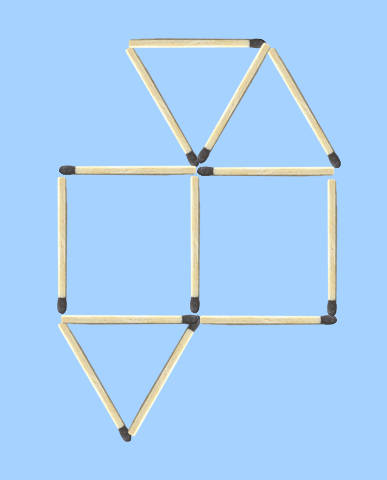
Comment
This is the first time we face a matchstick puzzle made up of regular matchstick shapes of different types—one triangle of 3 sides, two squares and one tilted closed shape of 4 sides that is called a rhombus.
If you make a closed shape using matchsticks of the same length, all sides of the shape will be of equal length. In geometry, such a shape is called a regular shape.
A matchstick triangle (which is an equilateral triangle) is a regular matchstick shape, whereas you can make two types of closed regular matchstick shapes with 4 matchsticks—a square and a rhombus with tilted sides.
Because of the different types of regular shapes as components, you can classify this puzzle as a matchstick puzzle of mixed matchstick shapes.
Concepts needed to solve the mixed matchstick shapes puzzle
Common stick properties
A common stick between two closed matchstick shapes,
- destroys two regular matchstick shapes if removed,
- reduces the need for the number of sticks to form the two matchstick shapes independently by 1.
Diagonals of a square and a rhombus
In a regular shape like a rhombus A in the puzzle figure shown below, you can place a stick as the shorter diagonal to divide the rhombus into two triangles, increasing the number of closed shapes by 1.
Note:
Geometrically, the shorter diagonal divides a rhombus into two equilateral triangles. But you won’t use any geometry or math concepts in solving matchstick puzzles, isn’t it?
You’ll just try out the possibility by actually placing a stick to connect two nearer corners of the tilted four-sided closed shape and check for yourself whether you have got two triangles as a result.
But you can’t use a stick as the diagonal of a square because diagonal is always longer than any of its sides in a square.
Two triangles can form a rhombus but not a square
As you can place a stick as the shorter diagonal in a rhombus, effectively you can combine two triangles to form a rhombus, but not a square.
These concepts you can understand just by creating the shapes with sticks. You don’t really need any geometry background.
We will now solve the puzzle systematically by step-by-step reasoning.
Solution: Move 1 stick to make 4 matchstick shapes the matchstick puzzle
Stage 1: Analysis of requirement: define precisely what is needed—Making initial conclusions
The puzzle figure below has 4 closed shapes as components and the target figure also would have 4 closed shapes.
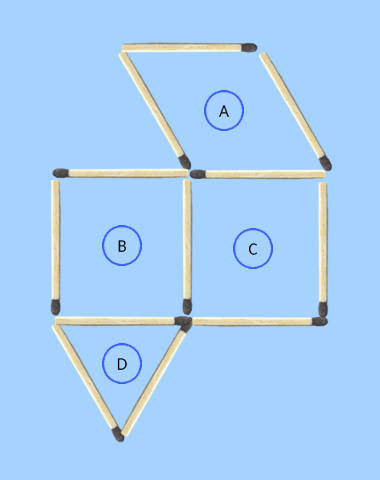
So you can confidently make your first conclusion,
The stick to be moved must destroy exactly 1 regular shape.
Verify and understand why this is true.
As a result, you can follow up with your second confirmed conclusion easily,
No common stick can be moved in this case.
These two conclusions are easy to make, but don’t help much to bring the solution within easy reach. Few, only three common sticks, are removed from consideration.
Second phase analysis: Going into more details
You’ll avoid rhombus A because moving any of its 3 eligible sticks would create two hanging sticks—a complexity. You are aiming for the simplest promising path to a solution now.
So you would consider moving 1 out of 2 eligible sticks from the closed shapes B, C or D. Such an action will create a single hanging stick that is not a side of any closed shape.
Stage 2: More precise requirement specification for the stick to be moved
After examining the three pairs of movable sticks in shapes B, C and D, you can make the requirement of a stick to be moved more precise,
Moving a non-common stick out of possible two from a shape should create 1 hanging stick that should already be a side of an INCOMPLETE shape with only one side missing. Then the stick that has been moved can immediately be used for creating a new shape.
This is a precise requirement specification arrived at in two steps and the solution is just a simple step away.
Stage 3: Applying requirement specification on the physical problem puzzle figure
Now, as you look at the puzzle figure with this precise knowledge, it takes just a few seconds to identify the stick 1 of square B as the stick to move.
Final solution: Move 1 stick to make 4 matchstick shapes matchstick puzzle
Move stick 1 of shape B to form a new shape E adjacent to shape A.
Shape B is destroyed and new shape E is created keeping the number of shapes unchanged to 4 as before.
The solution is shown.
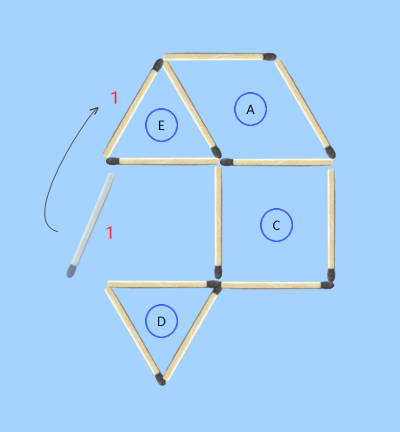
Part II of the move 1 stick to make 4 matchstick shapes matchstick puzzle: Any more solutions?
Solving the second part of the puzzle is easier now because you have already specified the requirements for the stick to be moved.
For convenience, it is shown again,
Moving a non-common stick out of possible two from a shape should create 1 hanging stick that should already be a side of an INCOMPLETE matchstick shape with only one side missing. Then the stick that has been moved can immediately be used for creating a new matchstick shape.
Does it help in finding any other solution immediately?
No, it doesn’t.
But it helps to eliminate shape C from consideration.
What about shape A that you had ignored in the beginning?
Now, as you look more closely at shape A, you could see in no time that moving the rightmost stick 2 in shape A would give you the second solution.
Second solution: Move 1 stick to make 4 matchstick shapes matchstick puzzle
Move stick 2 of shape A and form a triangle using this stick and the two hanging sticks as the other two sides.
The second solution figure is shown.
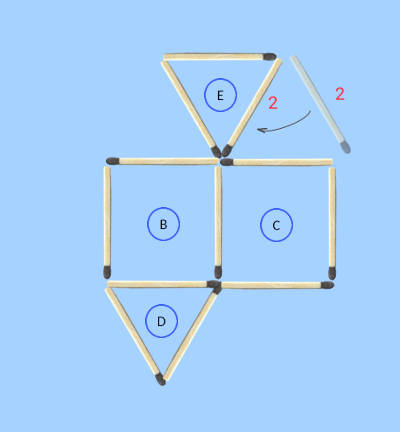
With this experience of increased knowledge you can now form a generalized requirement specification for the stick to be moved,
The stick to be moved must destroy only one shape with the rest of the hanging sticks (possibly with existing sticks of other shapes) forming an INCOMPLETE shape with only one side missing so that the stick moved can be used in forming a new closed shape.
Refining requirement specification step by step should generally be a great help in solving even complex problems systematically.
Apart from stick 1 in solution 1, only the stick 2 in shape A satisfied this precise but general requirement specification of a stick that is to be moved. The two other hanging sticks were conveniently positioned so that the stick 2 could form a new triangle destroying the existing rhombus.
These two are then the only two solutions possible.
Mark that for solution 1, the single hanging stick alone was not enough to form a new triangle. The second side of the triangle, E was supplied by an existing stick of shape A.
Solution to the bonus puzzle: Move 1 stick to make 5 matchstick shapes matchstick puzzle
The puzzle element is hidden in this puzzle, in the puzzle definition itself.
To solve it, you must first define the puzzle problem clearly by asking the critical question,
How many closed matchstick shapes of 3 or 4 sides does the puzzle figure have?
The number of closed matchstick shapes to start with is not 5 as it seems to be. The two triangles joined together top right form another additional outer 4 sided closed shape of a rhombus.
So the number of closed matchstick shapes to start with is 6.
And you have to move one stick to reduce the number to 5.
The only possible solution is shown.
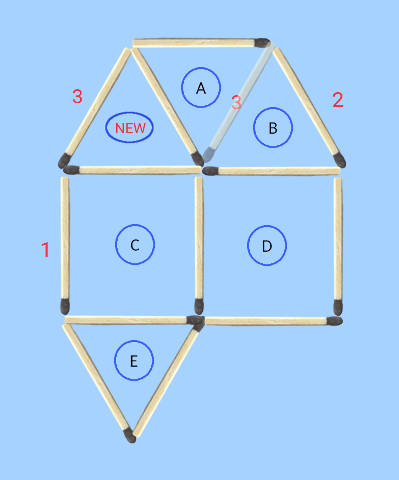
To reduce the number of matchstick shapes by 1 in a single stick move,
The stick that is to be moved must destroy two matchstick shapes and is placed in a new position to create a new matchstick shape. That means, it must be a COMMON STICK.
If you reason this way, you would be able to easily cancel the possibilities of moving stick 1 or stick 2 as ineligible moves and home in to the only possible stick to be moved as stick 3.
End note
Solving a puzzle by step-by-step reasoning takes away the joy of discovery of the solution in whatever-possible-way-I-can-solve attempts. Isn’t it?
That’s why we strongly recommend that you should try to solve the puzzle all by yourself in your own way and then only go through the reason-based solution to appreciate the best of both worlds,
A combination of intuitive and reason-based solution approach should produce a very satisfying overall experience, you know.
Know how to solve difficult problems easily without wasting time on random attempts
Our ebook on puzzle solutions by innovative methods will show you just that.
Puzzles for Adults: 50 Brain Teasers with Step-by-Step Solutions: Boost Your Power of Problem Solving
BUY the eBook Amazon Kindle version here, from Google Play here and Paperback here.
Second book on Innovative Solutions to Matchstick Puzzles from Suresolv

BUY Creative Matchstick Puzzles Innovative Solutions eBook Amazon Kindle version
BUY the paperback here.
Puzzles you may enjoy
Easy to hard brain teasers with systematic solutions
Challenging brain teasers with solutions: Long list.
This will always be the most up-to-date full list with the brain teasers classified into categories that can be browsed separately.
You may also click on the category term link below to enjoy the brain teasers that are classified in the present category.
For example, if the category term link shown below is "Riddle", click on it to go through all the Riddles.

